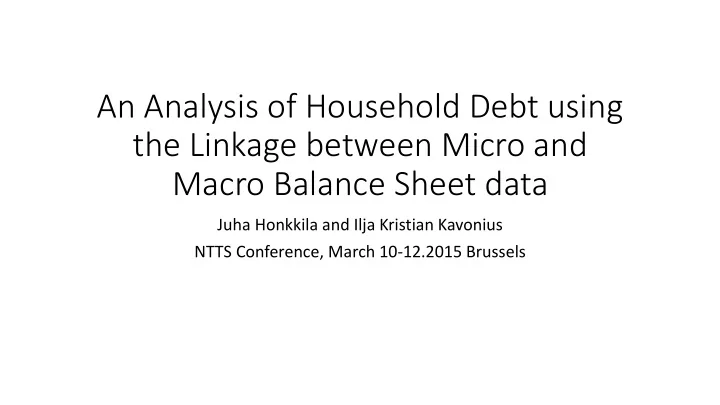

An Analysis of Household Debt using the Linkage between Micro and Macro Balance Sheet data Juha Honkkila and Ilja Kristian Kavonius NTTS Conference, March 10-12.2015 Brussels
Purpose of the paper • Financial stability and welfare analysis • Financial stability requirements for timely data for potential balance sheet risks (for instance the IMF/FSB report to the G-20 Finance Ministers and Central Bank Governors) • The rise of the GDP and Beyond discussion (Sitklitz-Sen-Fitoussi, Piketty …) • Identifying vulnerable household groups • Risk of financial insolvency caused by high indebtedness compared to income and/or wealth • Combined use of micro and macro data • More timely distributional data
Methodology • Wealth concept: hybrid concept using items that are comparable across the two sources only • Deposits, mutual fund shares, quoted shares, bonds and other debt securities, pension funds and life insurance • Including every item from the macro framework would require too much estimation and increase the uncertainty of the results • Target population adjustments • Non-profit organisations serving households and institutionalised households not included in survey target population • Levels and changes in levels from macro data, distribution from micro data
Debt to income ratio by income quintile 140 120 100 80 60 40 20 0 DE FR GR ES I II III IV V
Financial leverage ratio by income quintile 140 120 100 80 60 40 20 0 DE FR GR ES I II III IV V
Debt to asset ratio by income quintile 25 20 15 10 5 0 DE FR GR ES I II III IV V
Changes in financial leverage ratio by income quintile 25.0 20.0 15.0 10.0 5.0 0.0 DE FR GR ES -5.0 -10.0 -15.0 I II III IV V
Time series aspect in DE, FR and ES
Next steps • Development of time series analysis • Differences in the economic behavior across income quintiles during recession • The significance of the top 1%
Recommend
More recommend